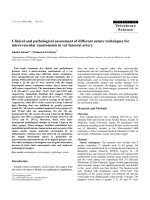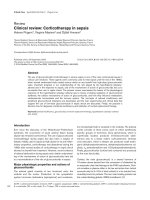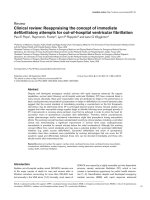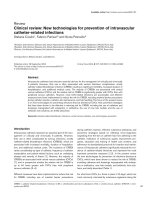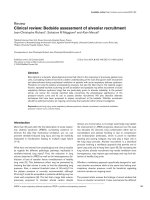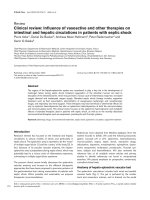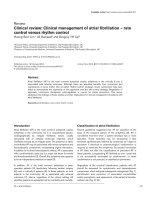Báo cáo khoa học: "Clinical review: Bedside assessment of alveolar recruitment" doc
Bạn đang xem bản rút gọn của tài liệu. Xem và tải ngay bản đầy đủ của tài liệu tại đây (211.79 KB, 7 trang )
163
ARDS = acute respiratory distress syndrome; PEEP = positive end-expiratory pressure.
Available online />Introduction
More than 30 years after the first description of acute respira-
tory distress syndrome (ARDS), cumulating evidence re-
inforces the idea that mechanical ventilation, per se, can
promote ventilator-induced lung injury and may be indirectly
implicated in mechanisms leading to multiple organ failure
[1–4].
What have we learned from physiological and clinical studies
as regards the different pathologic pathways implicated in
ventilator-induced lung injury? First, the reduction in lung
volume observed in ARDS as well as the heterogeneous dis-
tribution of loss of aeration favors overdistension of healthy
lung units [5]. This deleterious effect may be prevented by
lowering the tidal volume in order to limit the distending lung
pressure. Also, a maximal threshold value of 30 cmH
2
O for
the plateau pressure is currently recommended, although
35 cmH
2
O could be acceptable in patients exhibiting very low
chest wall compliance [6]. The fact that a large tidal volume,
previously proposed to maintain arterial carbon dioxide
tension at a normal value, is no longer used today may explain
the improvement in ARDS prognosis observed over the past
two decades [7]. Second, lung condensation either due to
consolidation and alveolar flooding or due to compression
and re-absorption atelectasis, which is prone to repetitive
opening and cycling collapse, may also play a major role in
the lung injury process. Alveolar recruitment is a beneficial
process involving a ventilatory approach that permits one to
open lung units and to keep them open [8]. By increasing the
lung volume, alveolar recruitment may render ventilation more
homogeneous, may improve gas exchange and may limit dis-
tention of healthy lung units.
Whether a ventilatory approach specifically designed to opti-
mize alveolar recruitment while at the same time limiting end-
inspiratory alveolar pressure could be beneficial regarding
outcome remains an ongoing issue.
The present article reviews the findings of recent studies that
focus on alveolar recruitment. It also summarizes the different
Review
Clinical review: Bedside assessment of alveolar recruitment
Jean-Christophe Richard
1
, Salvatore M Maggiore
2
and Alain Mercat
3
1
Medical Intensive Care Unit, Rouen University Hospital, Rouen, France
2
Department of Anaesthesiology and Intensive Care, Agostino Gemelli Hospital, Università Cattolica del sacro cuore, Rome, Italy
3
Angers University Hospital, Angers, France
Correspondence: Jean-Christophe Richard,
Published online: 22 October 2003 Critical Care 2004, 8:163-169 (DOI 10.1186/cc2391)
This article is online at />© 2004 BioMed Central Ltd
Abstract
Recruitment is a dynamic physiological process that refers to the reopening of previously gasless lung
units. Cumulating evidence has led to a better understanding of the rules that govern both recruitment
and derecruitment during mechanical ventilation of patients with acute respiratory distress syndrome.
Therefore not only the positive end-expiratory pressure, but also the tidal volume, the inspired oxygen
fraction, repeated tracheal suctioning as well as sedation and paralysis may affect recruitment of acute
respiratory distress syndrome lungs that are particularly prone to alveolar instability. In the present
article, we review the recently reported data concerning the physiological significance of the
pressure–volume curve and its use to assess alveolar recruitment. We also describe alternate
techniques that have been proposed to assess recruitment at the bedside. Whether recruitment
should be optimized remains an ongoing controversy that warrants further clinical investigation.
Keywords acute lung injury, acute respiratory distress syndrome, alveolar recruitment, mechanical ventilation,
pressure–volume curve, volume history
164
Critical Care June 2004 Vol 8 No 3 Richard et al.
methods currently available for bedside assessment of alveo-
lar recruitment.
Physiological meaning of alveolar
recruitment
Recruitment is a physiological process that refers to the re-
aeration of a previously gasless lung region exposed to posi-
tive pressure ventilation. The heterogeneous distribution of
condensations that predominates in the dependent part of
the lung has been attributed to the gravitation forces due to
the weight of the edematous lung [9]. This interpretation,
according to which lung collapse may be counterbalanced by
positive end-expiratory pressure (PEEP), could be considered
too simplistic and has been recently challenged [10]. First,
because the caudal lung regions are exposed not only to the
lung weight, but also to the pressure directly due to the
abdominal weight throughout the postero-diaphragmatic
region as well as due to the heart and the mediastinal struc-
tures [4]. More importantly, the lung may be nonaerated
because it is filled with fluid resulting from inflammation and
not because it is collapsed.
Computer tomographic analyses obtained in ARDS patients
have largely contributed to the better understanding of the
physiological mechanisms surrounding recruitment and de-
recruitment [11,12]. Nevertheless, one should accept that
knowledge regarding recruitment and derecruitment remains
uncertain. As previously suggested, ARDS is in fact a
complex disease. The two mechanisms involved (namely lung
collapse and lung consolidations due to fluid-filled alveoli),
recently discussed in detail elsewhere, may depend on the
origin of ARDS (i.e. pulmonary ARDS versus extrapulmonary
ARDS) and may also probably coexist in a given patient
[12,13]. Even if the distinction between these two mecha-
nisms required attention and further investigation, this debate
does not change the fact that recruitment refers to the part of
the lung that is not aerated at low airway pressure and that
requires high opening pressure to be re-aerated [10]. The
pressure–volume curve technique has been proposed to
quantify this alveolar recruitment.
Physiological approach for alveolar
recruitment evaluation
ARDS is a clinical situation resulting from varying etiologies
that is characterized by a natural tendency for alveolar insta-
bility and a loss of aeration. In addition to currently recom-
mended low peak pressure ventilation, many factors including
high fraction of inspired oxygen, sedation, the supine position
and repeated tracheal suctioning may favor alveolar derecruit-
ment. In this context, several authors have attempted to evalu-
ate and quantify the influence of different ventilatory settings
on recruitment.
By avoiding expiratory lung derecruitment, PEEP remains the
cornerstone of the ventilatory approach. This beneficial effect
has been widely investigated and is today largely accepted
even if its optimal level remains controversial. Katz and col-
leagues were the first to quantify the amount of recruitment
induced by PEEP [14]. To accomplish this goal, they
assessed the end-expiratory lung volume change, due to a
PEEP increase, by continuously recording the inspired and
expired tidal volumes as well as changes in peak pressure. An
interesting finding of this study was that PEEP-related recruit-
ment is a time-dependent process requiring roughly
10–15 breaths to be fully accomplished. Nevertheless, in this
experiment the change in end-expiratory lung volume ana-
lyzed solely does not permit one to differentiate the volume
caused by recruitment of previously nonaerated lung units
and the volume due to the expected inflation of already open
lung units.
In order to differentiate these volumes, one should compare
the lung volume measured at a given airway pressure when
the patient is ventilated with PEEP with the corresponding
volume obtained at the same pressure level during an inflation
without PEEP. This approach is based on the assumption
that the end-expiratory lung volume measured at zero end-
expiratory pressure is not affected by the level of PEEP used
before the measurements. This assumption has been
adopted by Ranieri and colleagues, who proposed to assess
recruitment by superimposing pressure–volume curves
recorded from PEEP and zero end-expiratory pressure on a
common volume axis [15]. The first volume point of the PEEP
pressure–volume curve therefore corresponds to the
increase in end-expiratory lung volume induced by PEEP (i.e.
the difference in end-expiratory lung volume between PEEP
and zero end-expiratory pressure). This volume may be reli-
ably measured during a prolonged expiration from PEEP to
zero end-expiratory pressure. For a given airway pressure, the
volume difference between the curve recorded from PEEP
and the curve recorded from zero end-expiratory pressure
corresponds to alveolar recruitment (Fig. 1).
The lack of any alveolar recruitment is indicated by the super-
position of PEEP and zero end-expiratory pressure volume
curves. Using this technique, Jonson and colleagues quanti-
fied recruitment in a series of ARDS patients ventilated with a
PEEP level set approximately above the lower inflexion point
[16]. PEEP induced an upward shift of the PEEP
pressure–volume curve in all patients, indicating recruitment.
Interestingly, recruitment was associated with a significant
decrease in the slope of the PEEP pressure–volume curve,
namely the cord compliance, compared with the curve per-
formed from zero end-expiratory pressure. Jonson and col-
leagues suggested that the chord compliance read on the
zero end-expiratory pressure–volume curve reflects the con-
tinuous recruitment that roughly starts at the lower inflexion
point and continues far above it. Based on this interpretation,
the upper inflexion point could be viewed as the end of this
continuous recruitment rather than as the beginning of alveo-
lar distension even if both mechanisms are in fact associated
at a high level of transpulmonary pressure.
165
These findings have been corroborated using a mathematical
lung model recently proposed by Hickling, who simulated the
behavior of the respiratory system submitted to a different
level and distribution of alveolar opening pressure (Fig. 2) [17].
The shape of the different zero end-expiratory pressure–
volume curves obtained with the simulation is very close to
those curves obtained in patients. Interestingly, the author
suggested that the absence of an upper inflexion point did not
necessary indicate the lack of overdistension since continuous
recruitment may mask the flattening upper part of the curve.
Maggiore and colleagues proposed an original automatic tech-
nique to assess recruitment obtained at different PEEP levels
without modifying baseline ventilation [18]. A low flow inflation
maneuver is programed to occur after a prolonged expiration
automatically performed at 15 cmH
2
O, at 10 cmH
2
O, at
5 cmH
2
O and at zero end-expiratory pressure. The most impor-
tant finding of this study was to demonstrate that the increase
of PEEP above the lower inflexion point resulted in a significant
further recruitment that was correlated with the linear compli-
ance of the zero end-expiratory pressure–volume curve. These
results show that the lower inflexion point is definitively not a
‘magic’ point reflecting the opening pressure of the lung. More-
over, the clinical relevance of the study is high since the lower
inflexion point of the zero end-expiratory pressure–volume
curve is widely proposed to set PEEP. For the reasons dis-
cussed, this approach may be misleading.
Overall, the physiological principle of the multiple
pressure–volume method initially proposed by Ranieri and
colleagues seems to allow a reliable assessment of alveolar
recruitment, whereas indications provided by this technique
regarding overdistension should be cautiously interpreted.
Nevertheless, one should note that the pressure–volume
curve technique has not been compared with an independent
method as regards recruitment assessment. Caution is there-
fore required concerning the exact interpretation of PEEP-
related recruitment quantified using this technique even if the
clinical relevance of recruitment is currently widely accepted.
Effect of different ventilatory settings on
alveolar recruitment
Although the effect of PEEP on alveolar recruitment has been
widely investigated, the influence of the tidal volume has
remained unknown until recently. Lung alveolar derecruitment
associated with a low tidal volume is now documented and
may represent an undesirable effect of the ‘low-stretch’ venti-
latory strategy. Supine patients exposed to repetitive tracheal
suctioning, to high fraction of inspired oxygen and to paralysis
are particularly prone to this deleterious effect, which is
related to volume history.
Ranieri and colleagues were the first to specifically investi-
gate the effect of tidal volume reduction on alveolar recruit-
ment measured by the pressure–volume curve technique
[19]. These authors observed that PEEP led to a greater alve-
olar recruitment with low tidal volume compared with high
Available online />Figure 1
Measurement of positive end-expiratory pressure (PEEP)-induced
alveolar recruitment using the pressure–volume (PV) curve. The PV
curves of the respiratory system recorded from zero end-expiratory
pressure (ZEEP) and from PEEP are superimposed on a common
volume axis. ‘0’ volume corresponds to the end-expiratory lung volume
(EELV) on ZEEP. The first point of the PEEP PV curve corresponds to
the increase in EELV induced by PEEP (∆EELV). On this example, the
recruitment induced by PEEP is measured at a pressure of 20 cmH
2
O.
Pressure
Volume
20 cmH
2
O
Recruited volume
ZEEP
PEEP
∆ EELV
Figure 2
Mathematical model of the pressure–volume (PV) curve. PV curves
obtained with a mathematical model simulating a multicompartmental
lung model. The continuous PV curve reflects elastic properties of a
completely recruited lung. The other curves represent the behavior of
the simulated models according to a different mean opening pressure
(10 cmH
2
O, 15 cmH
2
O and 20 cmH
2
O). Modified from [17]. P
el
,
elastic pressure; mPcrit =10, mean opening pressure of 10cmH
2
O;
sdPcrit = 4 cmH
2
O, standard deviation of mPcrit.
166
tidal volume. Their interpretation was that low plateau pres-
sure ventilation renders the lungs more recruitable. These
results slightly differ from those obtained by Richard and col-
leagues, who compared the effect on alveolar recruitment of
10 ml/kg tidal volume with 6 ml/kg tidal volume for a similar
PEEP level set at the lower inflexion point [20]. Recruitment
calculated as the volume difference between the PEEP pres-
sure–volume curve and the corresponding zero end-expira-
tory pressure–volume curve was significantly reduced when
patients were ventilated with the low tidal volume, demon-
strating that a reduction in plateau pressure promotes alveo-
lar instability. This derecruitment was fully regained by the
application of two consecutive sighs. Significantly, recruit-
ment obtained after the increase of the PEEP level 4 cmH
2
O
above the lower inflexion point largely exceed those obtained
after the recruitment maneuver, suggesting that PEEP
remains the main determinant of recruitment.
Both studies demonstrate that the tidal volume, namely
volume history, may affect recruitment. Nevertheless, Ranieri
and colleagues observed a higher recruitment with low tidal
volume while recruitment measured in the study reported by
Richard and colleagues was significantly less with low tidal
volume ventilation. This apparent discrepancy is probably due
to the fact that zero end-expiratory pressure–volume curves
were performed immediately after a single expiration at zero
end-expiratory pressure in the latter study, while prolonged
ventilation at zero end-expiratory pressure preceding zero
end-expiratory pressure–volume curve recording may have
affected end-expiratory lung volumes in Ranieri and col-
leagues’ study. These results emphasize that the volume
history preceding measurement may significantly affect
recruitment evaluation.
Also investigated was the extent to which a similar plateau
pressure obtained with the combination of a low tidal volume
with a high PEEP compared with a pressure obtained with
the combination of a low PEEP with a high tidal volume may
differently affect recruitment [21]. In this experiment, the
recruitment obtained with the high PEEP level and the low
tidal volume largely exceeded the recruitment obtained with
the low PEEP and high tidal volume despite a similar plateau
pressure. These findings show that the magnitude of dere-
cruitment due to the reduction in tidal volume remains signifi-
cantly lower compared with the recruitment that results from
the PEEP increase. These data corroborated a computed
tomography physiological experimental study reported by
Pelosi and colleagues, in which the authors elegantly and
clearly demonstrated that both end-inspiratory pressure and
PEEP could affect lung recruitment [22].
Currently available methods to assess
alveolar recruitment in the routine practice
Pressure–volume curve at the bedside
Several techniques have been proposed to assess the static
mechanical properties of the respiratory system (chest wall
and lung) by recording the zero end-expiratory pressure–
volume curve. In an extended review, Lu and Rouby discuss
the limits and advantages of the different methods (static
versus quasi-static technique) and detail the procedure that
should be performed to record the pressure–volume curve
using the low flow inflation technique with currently available
ventilators [23].
Only two manufacturers, Taema and Hamilton, have at
present commercialized an automatic tool specifically
designed to automatically record the pressure–volume curve
on their ventilator: Horus (Taema, Antony, France) and
Gallileo (Hamilton, Rhäzúns, Switzerland). The technique pro-
posed by Taema is a low flow inflation (8 l/min) that allows
one to record the zero end-expiratory pressure–volume curve
from the zero end-expiratory pressure after a prolonged expi-
ration from the set PEEP level, taking into account the intrin-
sic PEEP (the expiratory pause preceding the inflation). A
cursor permits one to measure linear compliance and the
lower inflexion point. A maximal pressure and tidal volume
alarm renders the technique relatively safe and easy to
perform.
The working principle on the Hamilton ventilator is signifi-
cantly different since the variable that is controlled during the
inflation is the pressure and not the flow. This original
approach allows one to record the pressure–volume curve
from the zero end-expiratory pressure to a predefined maximal
pressure. The inspiratory flow therefore decelerates along
inflation. Interestingly, the system automatically records the
volume expired during the expiration from the set PEEP to the
zero end-expiratory pressure (i.e. end-expiratory lung volume
variation related to PEEP) and indicates this point on the
graph illustrating the pressure–volume curve. A cursor is also
available to compute linear compliance. According to the mul-
tiple pressure–volume curve technique discussed earlier, this
ventilator is the first to directly assess PEEP-related recruit-
ment by simply calculating the volume difference between the
first point of the PEEP pressure–volume curve and the
volume read on the zero end-expiratory pressure–volume
curve at the corresponding pressure. This method was com-
pared with the multiple occlusion technique on a bench
model mimicking different compliance and resistance combi-
nations [24]. The results obtained with the Gallileo method
were closed to those obtained with the multiple occlusion
technique except for a very low compliance value
(10 ml/cmH
2
O) where inspiratory flow could not be accu-
rately measured by the flow sensor. In this situation, the pres-
sure ramp could be increased at the higher value to maximize
inspiratory flow.
Alternative techniques
Mergoni and colleagues have reported an original method for
bedside measurement of PEEP-related alveolar recruitment
[25]. This method is based on the ability of modern ventilators
to set the inspiratory pressure very accurately and indepen-
Critical Care June 2004 Vol 8 No 3 Richard et al.
167
dently from the expiratory pressure. Using pressure-controlled
ventilation, these authors measured the volume expired
during a prolonged expiration from 20 cmH
2
O inspiratory
pressure to zero end-expiratory pressure. This volume repre-
sents the increase in volume induced by 20 cmH
2
O alveolar
pressure. The expiratory pressure used, before this test cycle,
can be set from 0 to 20 cmH
2
O. Alveolar recruitment induced
by PEEP is defined as the difference in expired volumes
recorded during two test cycles preceded by ventilation in
zero end-expiratory pressure and in PEEP (Fig. 3). Mergoni
and colleagues reported a good agreement between the
results obtained with this method and with the pressure–
volume curve method.
Ranieri and colleagues have reported a method that allows a
qualitative assessment of recruitment and overdistension
during tidal ventilation [26]. This method is based on the
analysis of the airway pressure trace during volume-controlled
ventilation with constant inspiratory flow. Assuming that resis-
tances are constant during inspiration, the shape of the
airway pressure–time curve indicates the change in compli-
ance during inflation. A concave downward shape indicates
that compliance increases during tidal inflation, suggesting
the occurrence of recruitment, while a convex downward
shape indicates that compliance decreases during tidal infla-
tion, suggesting the occurrence of overdistension (Fig. 4).
Ranieri and colleagues recently demonstrated that this analy-
sis could predict the risk of ventilator-induced lung injury
associated with various ventilatory strategies in an isolated rat
lung model [27].
Thoracic computed tomography was proposed in the 1990s
to evaluate the effect of different levels of PEEP on alveolar
recruitment. Initially, a single computed tomographic section
was used to assess recruitment defined as the decrease in
nonaerated lung units. This experimental technique has
largely contributed to better understand the influence of res-
piratory parameters on alveolar recruitment and ventilation
distribution [11,12]. Nevertheless, this technique may be
flawed because it ignores the recruitment that occurs in
poorly aerated lung units and therefore does not reflect the
recruitment that may occur in the entire lung. Malbouisson
and colleagues recently proposed a new computed tomo-
graphic method whereby recruitment was defined as the
volume of gas penetrating in poorly and nonaerating lung
units when PEEP is applied [28]. Data obtained with this
technique differed significantly from those obtained with the
approach proposed by Gattinoni and colleagues; the positive
correlation found with this new computed tomographic tech-
nique with the effect of PEEP on oxygenation indirectly sug-
gests that this approach may, in fact, be more accurate [12].
Nevertheless, computed tomographic assessment of alveolar
recruitment remains a technique not currently available in the
majority of intensive care units. An interesting review of this
computed tomographic approach has recently been pub-
lished [11].
Alveolar recruitment and arterial oxygenation
Arterial oxygenation is probably the most widely used criteria
for PEEP titration in daily clinical practice. Since recruitment
is the main mechanism by which the PEEP improves oxygena-
Available online />Figure 3
An alternative technique to assess recruitment: the equal pressure technique. Illustration of the technique proposed by Mergoni and colleagues
who measured recruitment without performing pressure–volume curves. Recruitment is computed by comparing the volume expired after pressure
breaths performed with the same distending pressure but at different positive end-expiratory pressure (PEEP) levels (5–15 cmH
2
O). (a–c)
Difference corresponding to the recruitment related to the different PEEP levels studied. Modified from [25]. P
ao
, airway pressure; Vol, volume; V
E
,
expired volume.
168
tion, it could be proposed to use arterial oxygenation as an
index of alveolar recruitment. Two recent studies showed a
significant positive correlation between PEEP-related recruit-
ment and arterial oxygenation [18,28]. The correlations found
in these two studies are unfortunately relatively weak, sug-
gesting that arterial oxygenation cannot reliably predict the
amount of recruitment induced by a given level of PEEP in an
individual patient.
Clinical implication
Ventilator-induced lung injury that results from both end-inspi-
ratory overdistension and end-expiratory cycling collapse is
recognized as a key feature implicated in the multiple organ
failure process. This statement, mainly based on experimental
findings, is now supported by the results of a recent random-
ized controlled trial clearly demonstrating that acute lung
injury mortality and inflammatory response can be significantly
affected by ventilator settings [29]. As a result, the use of a
low tidal volume to limit the end-inspiratory pressure is now
widely recommended. However, controversies remain regard-
ing the accepted optimal level of PEEP even if keeping the
lung aerated may be viewed as an important goal of the lung
protective ventilatory approach. How and to what extent
PEEP should be increased continues to be debated.
In this context, Rouby and colleagues recently proposed an
algorithm to determine the optimal PEEP level [30]. The strat-
egy they proposed not only takes into account the chest radi-
ographic distribution of lung condensations, but also
considers the characteristics of the pressure–volume curve.
According to their recommendations, a high PEEP level
should be tested in patients exhibiting a marked inflexion
point on the zero end-expiratory pressure–volume curve asso-
ciated with a homogeneous distribution of lung densities. In
fact, in this situation the probability of alveolar recruitment
largely predominates the risk of overdistension. In contrast, an
uneven distribution of lung consolidations associated with the
lack of lower inflexion point suggests that PEEP could
promote overdistension.
Finally, the most important question is to determine whether a
strategy aimed to improve alveolar recruitment is able to
improve outcome when a low tidal volume is used. Unfortu-
nately, this issue remains an ongoing question.
Conclusion
Alveolar recruitment is a key feature in the ventilatory manage-
ment of patients with ARDS. However, this approach should
be cautiously balanced with the risk associated with overdis-
tention. In this context, the pressure–volume curve represents
an interesting tool that may be used at the bedside to help
the caregiver in determining the optimal PEEP level. Never-
theless, the classical interpretation of the sigmoidal shape of
the curve by which critical opening pressure and overdisten-
sion may be reflected by the lower inflection point and the
upper inflexion point, respectively, has been widely dis-
cussed. The influence of volume history on recruitment, which
considers not only PEEP, but also the tidal volume and the
respiratory rate, should be taken into consideration in order to
better understand and interpret information reflected by the
pressure–volume curve recorded from zero end-expiratory
pressure. Limits of the different techniques currently available
Critical Care June 2004 Vol 8 No 3 Richard et al.
Figure 4
An alternative technique to assess recruitment: automatic analysis of the pressure–time curve. Illustration of the concept proposed by Ranieri and
colleagues to monitor recruitment and overdistension during tidal normal breaths. A mathematical equation allows one to analyze the aspect of the
inspiratory part of the airway pressure tracing during a breath obtained with a constant inspiratory flow. A concave downward shape of the
pressure–time curve reflects continuous recruitment (left panel) while a convex downward shape indicates overdistension (right panel) The straight
shape in the middle panel indicates the lack of recruitment and alveolar overdistension. Modified from [27]. P
L
, airway pressure.
169
to assess recruitment are also important to consider so that a
useful physiological tool can be transposed into routine prac-
tice. Whether recruitment should be considered as a thera-
peutic goal remains controversial and warrants further clinical
investigation.
Competing interests
None declared.
Acknowledgement
The authors thank Richard Medeiros, Rouen University Hospital
medical editor, for his valuable advice in editing the manuscript.
References
1. Dreyfuss D, Ricard JD, Saumon G: On the physiologic and clini-
cal relevance of lung-borne cytokines during ventilator-
induced lung injury. Am J Respir Crit Care Med 2003, 167:
1467-1471.
2. Dreyfuss D, Saumon G: Ventilator induced lung injury: lessons
from experimental studies. Am J Respir Crit Care Med 1998,
157:294-323.
3. Slutsky AS, Tremblay LN: Multiple system organ failure. Is
mechanical ventilation a contributing factor? Am J Respir Crit
Care Med 1998, 157:1721-1725.
4. Ranieri VM, Suter PM, Tortorella C, De Tullio R, Dayer JM, Brienza
A, Bruno F, Slutsky AS: Effect of mechanical ventilation on
inflammatory mediators in patients with acute respiratory dis-
tress syndrome: a randomized controlled trial. JAMA 1999,
282:54-61.
5. Puybasset L, Cluzel P, Chao N, Slutsky A, Coriat P, Rouby JJ, CT
Scan ARDS Study Group. A computed tomography scan
assessment of regional lung volume in acute lung injury. Am J
Respir Crit Care Med 1998, 158:1644-1655.
6. The American Thoracic Society, The European Society of Inten-
sive Care Medicine, and The Societé de Reanimation de Langue
Francais: International consensus in intensive care medicine:
ventilator-associated lung injury in ARDS. Am J Respir Crit
Care Med 1999, 160:2118-2124.
7. Jardin F, Fellahi JL, Beauchet A, Viellard-Baron A, Loubière Y,
Page B: Improved prognosis of acute respiratory distress syn-
drome 15 years on. Intensive Care Med 1999, 25:936-941.
8. Lachmann B: Open the lung and keep the lung open. Intensive
Care Med 1992, 18:319-321.
9. Pelosi P, D’Andrea L, Vitale G, Pesenti A, Gattinoni L: Vertical
gradient of regional lung inflation in adult respiratory distress
syndrome. Am J Respir Crit Care Med 1994, 149:8-13.
10. Hubmayr RD: Perspective on lung injury and recruitment.
Askeptical look at the opening and collapse story. Am J Respir
Crit Care Med 2002, 165:1647-1653.
11. Rouby JJ, Puybasset L, Nieszkowska A, Lu Q: Acute respiratory
distress syndrome: lessons from computed tomography of
the whole lung. Crit Care Med 2003, 31 (Suppl 4):s285-s295.
12. Gattinoni L, Caironi P, Pelosi P, Goodman LR: What has com-
puted tomography taught us about the acute respiratory dis-
tress syndrome? Am J Respir Crit Care Med 2001, 164:
1701-1711.
13. Gattinoni L, Pelosi P, Suter PM, Pedoto A, Vercesi P, Lissoni A:
Acute respiratory distress syndrome caused by pulmonary
and extrapulmonary disease. Am J Respir Crit Care Med 1998,
158:3-11.
14. Katz JA, Ozanne GM, Zinn SE, Fairley HB: Time course and
mechanisms of lung-volume increase with PEEP in acute pul-
monary failure. Anesthesiology 1981, 54:9-16.
15. Ranieri VM, Eissa NT, Corbeil C, Chause M, Braidy J, Matar N,
Milic-Emili J: Effects of positive end-expiratory pressure on
alveolar recruitment and gas exchange in patients with the
adult respiratory distress syndrome. Am Rev Respir Dis 1991,
144:544-551.
16. Jonson B, Richard JC, Strauss C, Mancebo J, Lemaire F,
Brochard L: Pressure–volume curves and compliance in acute
lung injury: evidence of recruitment above the lower inflection
point. Am J Respir Crit Care Med 1999, 159:1172-1178.
17. Hickling KG: The pressure–volume curve is greatly modified
by recruitment. A mathematical model of ARDS lungs. Am J
Respir Crit Care Med 1998, 158:194-202.
18. Maggiore SM, Jonson B, Richard JC, Jaber S, Lemaire F,
Brochard L: Alveolar derecruitment at decremental positive
end-expiratory pressure levels in acute lung injury: compari-
son with the lower inflection point, oxygenation, and compli-
ance. Am J Respir Crit Care Med 2001, 164:795-801.
19. Ranieri VM, Mascia L, Fiore T, Bruno F, Brienza A, Giuliani R: Car-
diorespiratory effects of positive end-expiratory pressure
during progressive tidal volume reduction (permissive hyper-
capnia) in patients with acute respiratory distress syndrome.
Anesthesiology 1995, 83:710-720.
20. Richard JC, Maggiore SM, Jonson B, Mancebo J, Lemaire F,
Brochard L: Influence of tidal volume of alveolar recruitment:
role of PEEP and a recruitment maneuver. Am J Respir Crit
Care Med 2001, 163:1609-1613.
21. Richard JC, Brochard L, Vandelet P, Breton L, Maggiore SM,
Jonson B, Clabault K, Leroy J, Boamarchand G: Respective
effects of end-expiratory and end-inspiratory pressures on
alveolar recruitment in acute lung injury. Crit Care Med 2003,
31:89-92.
22. Pelosi P, Goldner M, McKibben A, Adams A, Eccher G, Caironi P,
Losappio S, Gattinoni L, Marini JJ: Recruitment and derecruit-
ment during acute respiratory failure: an experimental study.
Am J Respir Crit Care Med 2001, 164:122-130.
23. Lu Q, Rouby JJ: Measurement of pressure–volume curves in
patients on mechanical ventilation: methods and significance.
Crit Care 2000, 4:91-100.
24. Aboab J, Zekri D, Clabault K, Mercat A, Bonmarchand G, Richard
JC: Evaluation d’une nouvelle technique de realization de la
courbe pression volume PV Tool par le ventilateur Galileo
Gold [abstract]. Réanimation 2002, 11 (Suppl 3):SP167.
25. Mergoni M, Volpi A, Bricchi C, Rossi A: Lower inflection point
and recruitment with PEEP in ventilated patients with acute
respiratory failure. J Appl Physiol 2001, 91:441-450.
26. Ranieri VM, Giuliani R, Fiore T, Dambrosio M, Milic-Emili J:
Volume–pressure curve of the respiratory system predicts
effects of PEEP in ARDS: ‘occlusion’ versus ‘constant flow’
technique. Am J Respir Crit Care Med 1994, 149:19-27.
27. Ranieri VM, Zhang H, Mancia L, Aubin M, Lin CY, Mullen JB,
Grasso S, Binnie M, Volgyesi GA, Eng P, Slutsky AS: Pressure–
time curve predicts minimally injurious ventilatory strategy in
an isolated rat lung model. Anesthesiology 2000, 93:1320-
1328.
28. Malbouisson LM, Muller JC, Constantin JM, Lu Q, Puybasset L,
Rouby JJ: Computed tomography assessment of positive end-
expiratory pressure-induced alveolar recruitment in patients
with acute respiratory distress syndrome. Am J Respir Crit
Care Med 2001, 163:1444-1450.
29. The Acute Respiratory Distress Syndrome Network: Ventilation
with lower tidal volumes as compared with traditional tidal
volumes for acute lung injury and the acute respiratory dis-
tress syndrome. N Engl J Med 2000, 342:1301-1308.
30. Rouby JJ, Lu Q, Goldstein I: Selecting the right level of positive
end-expiratory pressure in patients with acute respiratory dis-
tress syndrome. Am J Respir Crit Care Med 2002, 165:1182-
1186.
Available online />
